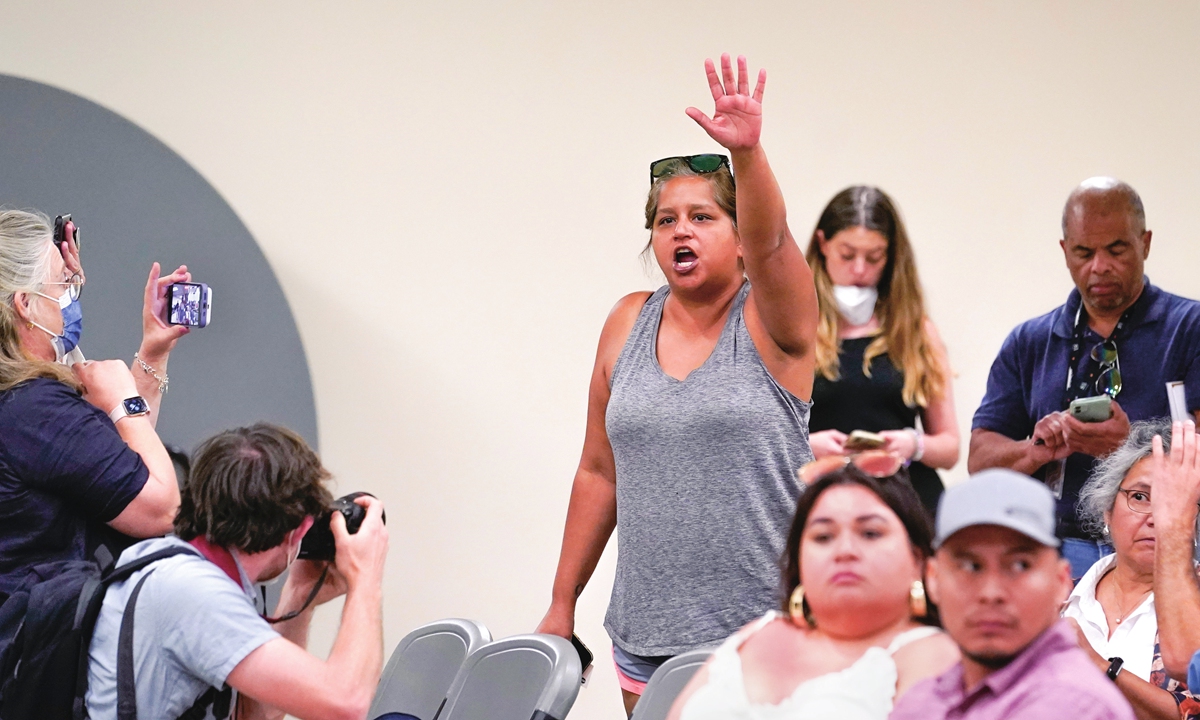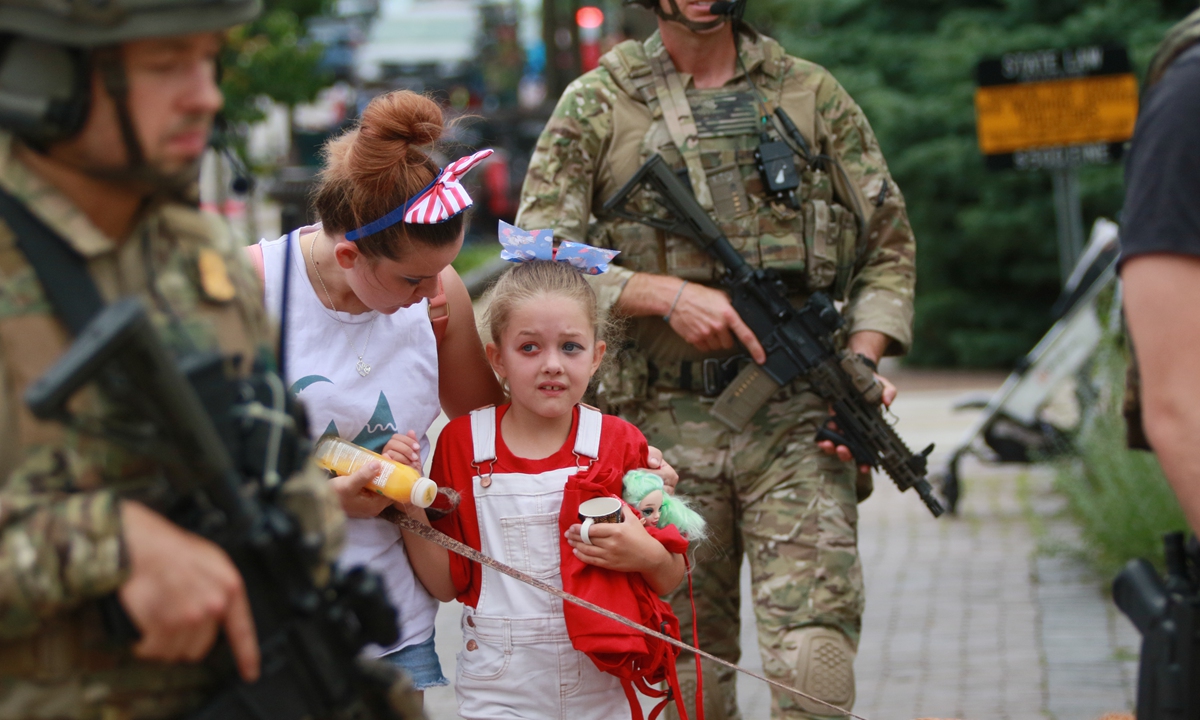
Tina Quintanilla-Taylor, a mother of a survivor of the shootings at Robb Elementary School, raises her hand and voice as she tries to ask the Texas House investigative committee a question at a news conference after they released a full report on the shootings on July 17, 2022, in Uvalde, Texas. Photo: VCG
With the gunshots of seven mass shootings in the US sounding in the background, an investigation report of the Uvalde school shooting in Texas, one of the deadliest in US recent history, was released on Sunday local time, which found "systemic failures" and poor leadership in response to the shooting as it took nearly 400 equipped officers more than 70 minutes to stop an 18-year-old shooter who killed 19 children and two adults on May 24.
The report underscored the dereliction of duty in one mission, but observers pointed out a notable trend that increasingly militarized US law enforcers, with full equipment, are incapable of properly handing emergencies like mass shootings.
The "systemic failures" of law enforcement is "the tip of the iceberg" in front of the failures of US' domestic governance, observers said, explaining that many deep social problems were expressed in the fiercest way such as mass shootings while the US system cannot alleviate or address them.
Failed law enforcement According to a 77-page investigation report on the Texas school shooting, law enforcement officers who responded to the rampage "failed to adhere to their active shooter training and failed to prioritize saving the lives of innocent victims over their own safety," ABC News reported Monday.
According to a footage that was obtained by news outlets and released online, hundreds of officers -- including some with protective shields, wearing tactical armor and armed with high-powered rifles -- didn't breach the classroom for more than 70 minutes, even as additional volleys of gunfire could be heard on the video from the classrooms 45 minutes after police arrived on the scene, ABC News reported.
Some police officers, who charged down the hallway only a few minutes after the shooter entered the classrooms, were seen in the video retreating after coming under fire.
The report laid out in detail the lapses in preparation, training and judgment in connection with the police response, for which families of the victims expressed extreme anger and disappointment.
"It's a joke. Texas failed the students. Law enforcement failed the students. Our government failed the students," Vincent Salazar, whose 11-year-old granddaughter was killed, told media.
Wei Nanzhi, a research fellow at the American Institute from the Chinese Academy of Social Sciences in Beijing, told the Global Times on Monday that behind the police inaction in Uvalde, and in some occasions excessive law enforcement, is the same logic that leads law enforcers to put self-protection on top of everything.
The self-protection is both in personal safety sense -- choosing not to confront a mass shooter holding unclear arms; and in legal sense -- blaming ineffective leadership and coordination in mission to shun personal duties in a mission, Wei elaborated.
Zhang Tengjun, deputy director of the Department for Asia-Pacific Studies at the China Institute of International Studies, noted US police are also deterred by the rampant gun violence, and the professional training and upgrading equipment did not ensure a reliable and capable police force.
Zhang said such scenario demonstrated the US law enforcement is facing a crisis in functioning, as it frequently finds itself inactive or overreacting, the latter can be seen in the case where unarmed black man Jayland Walker who was shot dead by a hail of bullets in Akron, Ohio, after the police suspected him of intended to fire a gun.
The law enforcement is also in a trust crisis because ordinary people increasingly feel the necessity to obtain a firearm to protect themselves, which aggravates excessive gun ownership and ultimately leads to more gun violence, Zhang said.
A fresh mass shooting on Sunday could serve as an annotation for this point. Three people were killed and two others injured after a shooter opened fire on Sunday in the food court of a shopping mall in Greenwood, Indiana. The shooter was shot and killed by a lawfully armed 22-year-old man who "observed the shooting in progress," CNN cited local police as saying.
The police inaction at an Uvalde school for immigrants, not elite children, and the death of Walker, a black man not white, laid bare the "tilted law enforcement" that was intertwined with US social inequality between different races and social classes, according to analysts.
The public services have been marketized in the US that people are not only born unequal, but also unequal during the COVID pandemic in receiving health services and unequal in the face of a mass shooting, Wei noted. "All are measured by wealth and capital."
A tracking from 2015 to June of 2022 shows that the rate of fatal police shootings for black people stood at 40 per million of the population, while for white Americans, the rate stood at 16 fatal police shootings per million of the population, according to data portal statista.com.

US law enforcers escort a family from the scene of a mass shooting at an Independence Day parade on July 4, 2022 in Highland Park, Illinois. Police have detained Robert "Bobby" E. Crimo III, 22, in connection with the shooting in which six people were killed and 19 injured. Photo: AFP
Deep failureSystemic failures in law enforcement were prominent in the Uvalde case, but Zhang described it as "tip of the iceberg" if compared to US' overall systemic failure, including the legislation dragged by partisan politics, the judiciary plagued by conservatism and administration whose policies are usually inconsistent and unsustainable.
The essence of US' rampant gun violence is deep economic, political, social and racial problems broke out in an intense manner, but the US system is not mediating or addressing the problems, Zhang said, citing the frequent Black Lives Matter protests and the recent Supreme Court ruling over abortion right as two typical examples.
The US system in crisis is not tackling the "superficial problem" of gun violence, either.
A month after the Uvalde shooting, a gun control act requiring background checks of buyers finally passed the Congress on June 23 following hard battles and compromises between the two parties.
But the next day, the Supreme Court ruled out a century-old New York law restricting the carrying of concealed firearms, laying bare its internal divisions and indifference to lives of ordinary people, observers said.
The US House Judiciary Committee will meet on Wednesday to discuss a proposed legislation that would ban certain assault weapons, the panel said on Friday, citing a string of recent mass shootings across the nation, Reuters reported.
The Hill, citing a few Congressmen, predicted the ban, even passed the House, can hardly get Republican support at a 50-50 Senate.
The US political landscape and its "democratic" procedures decide that gun control, as well as many other topics, continuously fuels battles in the US Congress and acts as vehicle for interest groups. As long as the problems are discussed, whether they are addressed becomes less important, Wei said in a previous interview with the Global Times.
Experts noted the ruling elites are even indulging public anger from inflation, economic slowdown and social divisions to be vented in a violent way, because when the deep problems are displayed as conflicts between police and common people or different races, the deep failure of the US system becomes invisible.





